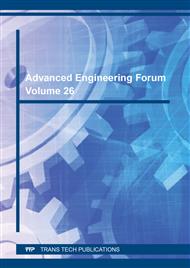[1]
E.Niemi, W.Fricke, S.J Maddox. Structural Hot-spot Stress Approach to Fatigue Analysis of Welded Components. Designers' Guide. Int. Institute of Welding, IIW–Doc. XIII–WG3–31r1–14 Cambridge. Abington. 2015. 49 p.
DOI: 10.1007/978-981-10-5568-3_2
Google Scholar
[2]
W.Fricke. Guideline for the Fatigue Assessment by Notch Stress Analysis for Welded Structures, IIW-Doc. XIII-2240r1-08/XV-1289r1-08 Cambridge. Abington. (2008).
DOI: 10.1533/9780857098566.3
Google Scholar
[3]
L.F. Coffin, J.F. Tavernelli. Experimental Support for Generalized Equation Predicting Low-Cycle Fatigue. Trans. ASME, Ser.D, 4, (1962), p.533.
DOI: 10.1115/1.3658701
Google Scholar
[4]
S.S. Manson. Fatigue: A Complex Subject - Some Simple Approximations, Experimental Mechanics, No 7, (1965), pp.193-225.
Google Scholar
[5]
EUROCODE 3: Design of Steel Structures. Part 1-9: Fatigue. BS EN 1993-1-9: P. 36.
Google Scholar
[6]
C.E. Feltner, and J.D. Morrow. Microplastic strain hysteresis energy as a criterion for fatigue fracture, Trans. ASME, Ser. D, 83, (1961), pp.15-22.
DOI: 10.1115/1.3658884
Google Scholar
[7]
V.S. Ivanova. Fatigue failure of metals, Metallurgizdat, Moscow. 1963 (in Russian).
Google Scholar
[8]
Det Norske Veritas. Fatigue Assessment of Ship Structures. Classification Notes № 30.7. (2010). Hovik, Norway.
Google Scholar
[9]
S.V. Petinov, I.M. Afanasyeva. Fatigue Assessment of Structures in High-cycle Segment: Technique and Problems. Proc., The XXXVII Intern. Summer School - Conference «Advanced Problems in Mechanics» APM-2010, SPb-Repino, 2010. pp.519-525.
Google Scholar
[10]
K. Hatanaka. Cyclic Stress-Strain Response and Low-Cycle Fatigue Life in Metallic Materials. JSME International J., Ser.1, Vol.33, No.1, (1990). pp.13-25.
DOI: 10.1299/jsmea1988.33.1_13
Google Scholar
[11]
N.A. Makhutov, M.I. Burak, M.M. Gadenin. Mechanics of Low Cycle Fatigue Failure. Nauka Publ., Moscow, 1986 (in Russian).
Google Scholar
[12]
H. Neuber. Theory of stress concentration for shear-strained prismatic bodies with arbitrary nonlinear stress-strain law. Journal of Applied Mechanics, 1961, 28 (4), pp.544-550.
DOI: 10.1115/1.3641780
Google Scholar
[13]
S.V. Petinov. Fatigue Analysis of Ship Structures. Backbone Publ. Co., NJ. (2003) P. 262.
Google Scholar
[14]
S.V. Petinov, R.V. Guchinsky. Fatigue Assessment of Tubular Structures // Magazine of Civil Engineering, No1 (36), (2013) pp.39-47.
DOI: 10.5862/mce.36.5
Google Scholar
[15]
R.E. Peterson. Stress Concentration Factors. A Handbook. J.Wiley & Sons, (1974) New York.
Google Scholar
[16]
F.Conti, L.Verney, A.Bignonnet. Fatigue assessment of tubular welded connections with the structural stress approach. «Fatigue Design 2009». 25-26 November 2009. Senlis, France, pp.1-8.
Google Scholar
[17]
S.V. Petinov, R.V. Guchinsky. Fatigue of a Fillet-welded Joint Assessment by the FEA Simulation of Damage Accumulation // Magazine of Civil Engineering. (2011) No4 (22), pp..5-9 ISSN 2071-4726.
DOI: 10.5862/mce.22.5
Google Scholar
[18]
M. Imran, S. Siddique, R. Guchinsky, S. Petinov and F. Walther. Comparison of fatigue life assessment by analytical, experimental and damage accumulation modeling approach for steel SAE 1045. Fatigue & Fracture of Engineering Materials & Structures, (2016).
DOI: 10.1111/ffe.12426
Google Scholar
[19]
M.A. Miner. Cumulative Damage in Fatigue. Trans. ASME, Journ. of Appl. Mech., Vol.67, 1945, pp.A-159-164.
Google Scholar
[20]
J.D. Morrow, et al Cyclic Plastic Strain Energy and Fracture of Metals. ASTM STP 378, (1965), pp.45-87.
Google Scholar
[21]
G.A. Glinka. Cumulative model of fatigue crack growth. International Journal of Fatigue, 4 (2), 1982, pp.59-67.
DOI: 10.1016/0142-1123(82)90061-5
Google Scholar
[22]
P.A. Pavlov. Basics of engineering assessment of fatigue of mechanical components. Mashinostroenie Publ., Leningrad branch, Leningrad. 1988 (in Russian).
Google Scholar
[23]
A.N. Romanov. Failure under low-cycle loading. Science Publ., Moscow. 1988 (in Russian).
Google Scholar
[24]
N.S. Yermolaeva, S.V. Petinov. Development of fatigue failure energy criterion, Preprint No 116, IPME, Russian Acad. Sci, St.Petersburg. 1995. 37 p. (in Russian).
Google Scholar
[25]
V.T. Troshchenko, L.A. Sosnovsky. Fatigue resistance of metals and alloys. Handbook, Naukova dumka Publ., Kiev. 1987 (in Russian).
Google Scholar
[26]
P.V. Yassni, V.T. Troshchenko. Fatigue crack growth. A model of the sub-critical growth, Problems of strength, No 11, 1989, pp.46-51. (in Russian).
Google Scholar
[27]
R.V. Guchinsky, T.I. Letova, S.V. Petinov. Modeling of Fatigue Process by Combining the Crack Initiation and Growth / Proc., The XLII Intern. Summer School - Conference «Advanced Problems in Mechanics» APM-2014, SPb-Repino, SPb, IPME RAS, 2014, pp.128-134.
Google Scholar


